#Maximilien François Marie Isidore de Robespierre
Text
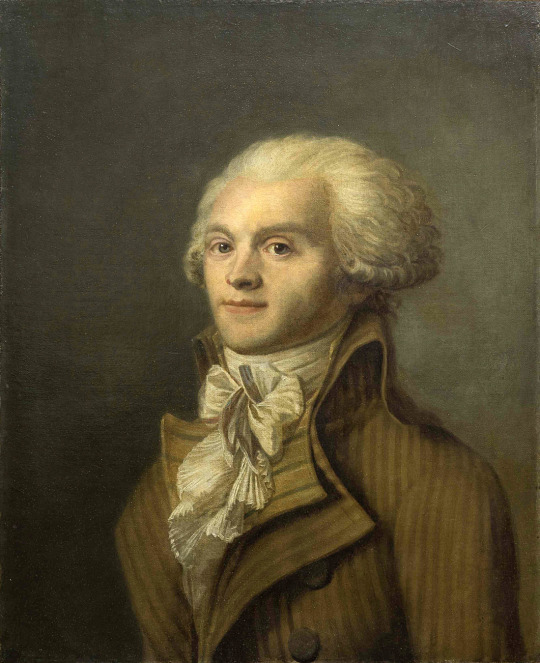
Maximilien François Marie Isidore de Robespierre (6 May 1758 - 28 July 1794)
Le seul tourment du juste, à son heure dernière,
Et le seul dont je serai déchiré,
C'est de voir en mourant la pâle et sombre envie
Distiller sur mon nom l'opprobre et l'infamie,
De mourrir pour le peuple et d'en être abhorré. (M. Robespierre)
Предсмертный час одной тоской грозит,
Тому, кто прожил жизнь правдиво, как укором.
Я буду ей как он разорван и разбит:
Желаньем запятнать злословьем и позором
Мне имя. Умереть, чтоб жил народ,
И ненависть его принять наградой. (М. Робеспьер)
Перевод Волковой Е.А.
7 notes
·
View notes
Note
Tell me the story of robespierre's father from the beginning.
[what happened to robespierre's father after he left? Did he leave his country? Or settled in another province after that? Did he never made any contact with one of his family? did his children knew anything about him through their lives like for example the time when he died?]

Maximilien Barthélémy François de Robespierre was born in Arras on 17 February 1732 and baptised five days later. There exists some controversy in regards to what his real first name was, considering we have one document designating him as Barthélémy-François, and another one as just Barthélémy (although ironically, it has been more common among authors to call him François and not Barthélémy). Historian Hervé Leuwers still insists that his real firstname seems to have been Maximilien, as it’s what his contemporary Abbé Proyart calls him in his La Vie et les Crimes de Robespierre: surnommé le tyran: depuis sa naissance jusqu’au sa mort (1795), as well as the only name indicating his inhumation in 1777.
Whatever the case, Maximilien was the oldest of five children (of which four reached adulthood). Their mother was Marie-Marguerite Françoise de Robespierre (born 1708, née Poiteau) and their father the lawyer Maximilien de Robespierre (born 1694).
On April 21, 1749, a seventeen year old Maximilien presented himself, along with his companion the Sieur Gorbu, to the monks of Dammartin to prepare his novitiate. But June 17 the same year, he declared to the abbot "that he was not made for the religious stall, and had only desired it in order to please his parents.” He therefore left and returned to his hometown. After classical studies at the Jesuit college in Arras, he studied law at the University of Douai, where he obtained his license, and on December 30, 1756, he was received as a lawyer at the Council of Artois and took the required oath.
The reports we have regarding Maximilien’s persona are few, often contradictory, and perhaps colored more by what its authors thought about his son with the same name than by the actual facts. The two most used accounts are on one hand the memoirs (1834) of his oldest daughter Charlotte, who is bias in his favor, and on the other hand the aforementioned La Vie et les crimes de Robespierre, surnommé Le Tyran… (1795) by his contemporary Liévin-Bonaventure Proyart, who is holtile towards him. According to the latter, Maximilien was ”a lawyer with little occupation at the Superior Council of Artois. [He] had the reputation, in the town of Arras, to be somewhat scatterbrained, and above all, fond of his own opinions.” Charlotte on the other hand writes that her father ”had acquired great consideration by his probity and his virtues; he was honored and cherished by the whole town.” According to La jeunesse de Robespierre et la convocation des Etats généraux en Artois (1870), Maximilien was charged with 34 cases in 1763 and 32 in 1764, which suggests he carried some prestige as a lawyer. A thermidorian pampleth it also titled La Jeunesse de Robespierre still claims that Maximilien ”had lights and probity, but his economy was not a virtuous one. Not knowing how to proportion the product of his labor to expenses, he sought resources in loans, contracted debts and died insolvent” and M. Devienne, former procureur at the Council of Artois, called him ”un avocat pauvre et un pauvre avocat.”
At some point, Maximilien met Jacqueline Marguerite Carraut (born 1735), daughter of an arragois brewer. On January 2 1758, when Jacqueline was already around four months pregnant, their marriage contract was signed before M. Crépieux and M. Botte, notaries, M. Corroyer, prosecutor, as well as Jacqueline’s mother Marie-Marguerite Carraut (born 1693, née Cornu), father Jacques-François Carraut (born 1701) and younger brother Augustin-Isidore Carraut (born 1737). One day later the wedding ceremony was held, now in the presence of M. Monvoisin, practitioner, M. Corroyer, prosecutor, M. Botte, notary, Jacques-François Carraut and Augustin Carraut. Maximilien’s parents, as we can see, were present for neither of these two events, perhaps a sign they disapproved of the hasty marriage that was undoubtly related to Jacqueline’s pregnancy. We can however imagiene they made their peace, considering Maximilien’s father was made godfather of the expected child when it was born in May the same year. Maximilien’s mother was also made godmother of the couple’s third child, born three years later.
On April 17 1762 Maximilien’s father died, at the age of 67. Maximilien’s name featured on the death certificate when he was buried in the church of Saint-Aubert two days later. When his wife Jacqueline on July 16 two years later died in the aftermath of the birth of their fifth child (that died as well) his signature does however elude said certificate.
On August 6 1764, Maximilien retook his duties as lawyer after having spent a few weeks without doing any business, winning and losing a case that very same day. However, on November 16 his name disappeared from the court register again, and on January 7 he was received as a lawyer at the court of Oisy, about 20 kilometers from Arras, after having been called on by Eustache-Joseph d'Assignies, count of Oisy, to take a prestigious seat there, “on the express condition of taking up residence in said Oisy and not being able to demand from us any sums for fees in criminal cases” eight days earlier.
It’s hard to tell if he had lived alone with his four children up until that point, or if he had handed them off to relatives right after his wife’s death. Regardless, the second option must at least have happened now. According to the memoirs of Charlotte, she and the youngest daughter Henriette went to live with their father’s two surviving siblings, Eulalie and Henriette, while their two brothers were taken in by their maternal grandparents.
If we’re to believe Abbé Proyart, this was not the first time Maximilien had abandoned his family, he had in fact already done so about a year before his wife’s death:
Either from oddity of character or inconvenience of profession, on the run from a lost lawsuit, he abruptly left his country, where he left his wife and the four children of whom we have just spoken. […] Robespierre, a few years after the disappearance of his father, lost his mother, and found himself orphaned at the age of nine [sic].
However, I could find no historian noting any absences in the court register prior to November 1764, so it’s possible Proyart is mistaken here.
Charlotte on the other hand, makes her father’s leave be all about a broken heart:
[Jacqueline] was no less of a good wife than a good mother. Her death was a lightning strike to the heart of our poor father. He was inconsolable. Nothing could divert him from his sorrow; he no longer pleaded, nor occupied himself with business; he was entirely consumed with chagrin. He was advised to travel for some time to distract himself; he followed this advice and left: but, alas! We never saw him again; the pitiless death took him as it had already taken our mother. I do not know what country he died in. He will have doubtless succumbed to a sorrow which became unsupportable.
While Charlotte’s version is harder to completely dismiss, it can at least be nuanced. Unlike what her account leads you to believe at first, this was far from the final time Maximilien sat foot in Arras, as will be seen below. It’s however hard to know if this means he was in contact with his children anymore after this. It can be observed that Charlotte, Maximilien and Henriette spent the majority of the year away at schools far from Arras since 1768, 1769 and 1771 respectively, so it’s unlikely they met their father during at least any of his later stays in the town.
On March 13 1765 Maximilien was back in Arras again, four months before the expiration of his position at Oisy. He started pleading a case that carried on all the way into December of the same year. From the same month we also have this rather ironic letter to his fellow lawyer Maximilien Baudelot, which confirms he was still active in Arras. In the letter, Maximilien tried to get the lawyers of the town to all come together and publicy plead for the betterment of the the ill dauphin (Louis XVI’s father) who passed away eleven days later:
Monsieur,
All the hearts taking their flight towards the sky, are resounding the aors of their plaintive accents; they pray, they conjure, they demand again with loud cries the worthy object of their love which they believe they have already delighted, so much do they fear losing it: ours are the only ones whose voices we do not hear; would they indeed be as mute and as motionless as they appear? No, mine answers for all; all at this moment breathe through it. I don’t know what has kept their movements secret until now, and they have undoubtedly prevented, in spite of themselves, from showing outside the fires of love which consume them within. Several times, I have seen it, we have come together to deliberate on certain matters which do not deserve our attention: deciding nothing then, is what we could have done best: only once when it is a question of giving the King a pure, solemn, and indispensable pledge of our attachment to the royal family, shall we fear that it might be said that we have assembled? Lawyers, this title honors us; subjects of France, is a quality a thousand times more glorious for us; it is only by fulfilling it as the most glorious of our duties, in a noble and uncommon manner, that we will truly prove the nobility of our profession and that we will maintain under the asylum of the throne freedom and independence. I expect, Monsieur, from your feelings, the justice due to mine. I have the honor to be with the deepest respect
Monsieur,
Your most humble and obedient servant
Derobespierre (sic), Lawyer
Arras December 9th 1765
We find Maximilien pleading yet another case in Arras on March 3 1766. A few weeks later, on March 22, he borrowed seven hundred livres from his sister Henriette, who supposedly asked that he in turn resign from any inheritance from their mother. Two years later, on October 30 1768, we therefore find the following note:
I, the undersigned, lawyer at the Provincial Council of Artois, renounce, for the benefit of my sisters, my rights and shares in the movable and immovable estates of my mother, acknowledging that I have received from said mother beyond the share that I could claim, both for me and for my children.
Written at Arras, the thirtieth day of October, 1768
(Signed): DEROBESPIERRE
Sometime after this Maximilien left Arras again. His two sisters were however aware of his whereabouts, as they were able to inform him about their death of their mother on June 8, 1770. In return, Maximilien wrote the following note, confirming his resignation from the inheritance. As we can see from it, he was by then residing in the German town of Mannheim:
I, the undersigned, lawyer at the Provincial Council of Artois, hereby renounce for the benefit of my sisters all rights and shares in the movable and immovable estates of my late mother, acknowledging that I have received from said mother beyond the share that I could claim, both for me and for my children.
Written at Mannheim, June 8, 1770
On October 3 1771 Maximilien was once again back in Arras and once again affirming his resignation from the inheritance:
Before the undersigned royal notaries of Artois appeared M. Maximilien-Barthélemy-François de Robespierre, lawyer at the Superior Council of Arras, residing in said Arras.
Who recognized that, by an act made under his private signature, in the city of Mannheim, on the eighth day of June 1770, he declared that he renounced the movable and immovable successions of lady Marie-Marguerite-Françoise Poiteau, his mother, at the time of her death widow of M. Maximilien de Robespierre, lawyer at the Council of Artois. But, having since considered that this renunciation could not have its effect, considering that at that time, he did not have full and complete knowledge of the forces of said succession and that, since his return to this town, three months ago, he has taken perfect knowledge of said estates by inspecting the letters and papers abandoned by said mother, which Marie-Marguerite-Alexandrine-Eléonore-Eulalie and Amable-Aldegonde-Henriette de Robespierre, his sisters, represented and entrusted to him. This is why said sieur appearing has, hereby, declared to renounce said successions and to claim nothing hereunder, giving power to the bearer of the bulk hereof to reiterate where and to whom it will belong. And just now said ladies Marie-Marguerite-Alexandre-Eléonore-Eulalie and Aimable-Aldegonde-Henriette de Robespierre have appered; these have recognized that said sieur de Robespierre, their brother, has given them the titles and papers mentioned herein.
Passed in Arras, the third of October, 1771.
(Signed): de ROBESPIERRE; de ROBESPIERRE, the older; de ROBESPIERRE, the younger,
(and as notaries): MERCHIER, HUSSON.
Maximilien now returned to plead in Arras again for a while — his name reappears on the court register of the Council of Artois from February 17 to June 4 1772. After this however, there’s no sign of any activities in the town. In 1795, Proyart claimed to know more details about his whereabouts:
We had ignored until now the route he had taken. We have just discovered that on leaving his homeland, he went to Belgium, from where his family originated. He passed from there to Germany, and lived for some time in the town of Cologne, where, to survive, he opened a French school for children. Unsatisfied with his new profession, he left Cologne, announcing the intention of going to London and then to the Isles, where it was possible that he still lives: well done, in that case, if, by the silence of the differetion, he hides what would reflect upon him the shameful celebrity of his son.
Regardless, on November 6 1777 Maximilien was buried not in London but in Munich, aged 45. All historians I’ve checked up on have concluded that it’s unlikely his relatives found out about his death (as suggested by a decree written around 1795 by Armand Joseph Guffroy (old lawyer colleage of Maximilien II and friend/ally? of Charlotte), stating that ”their father who had abandoned them died in a hospital at [blank]” and Charlotte’s own memoirs where she underlines ”I do not know in which country he died”). It would however appear they settled with the conviction that he would never return, because when Maximilien’s sister Henriette and her husband François-Gabriel Durut in 1780 wanted to get back the money he had borrowed fourteen years later and never returned, they turned to his oldest son to get him to pay what his father owed rather than trying to get into contact with said father again:
Hearing of April 4, 1780: M. Corne, for François-Gabriel Durut, doctor of medicine, and Amélie-Aldegonde-Henriette Derobespierre, his wife; Against François-Maximilien-Barthelemy de Robespierre; Gentlemen give default against François-Maximilien Robespierre and for the benefit, hold the signature affixed by the defaulting party at the bottom of a recognition of March 22 1766 which it is about for recognized; Consequently, we condemn said defaulting party to pay to the parties of the attorney Corne, for one part, the sum of seven hundred and eleven livres ten sols, centenary in said recognition, and for another part, the sum of one hundred livres paid in his acquittal to the notary Husson, for pension provided to him according to the receipt of March 14, 1772 and in question, in the interest of the sums quoted from the day of the judicial demand and at the costs, liquidated at fifteen livres eighteen sols eight denarii.
-
Sources: same as for this post
35 notes
·
View notes
Text
Un día como hoy… (06 de mayo)
Un día como hoy... (06 de Mayo)
#aperturaintelectual
#undiacomohoyai
06 DE MAYO DE 2024 Un día como hoy…
LOS DATOS CULTURALES SON:
En 1758 nacía en la provincia de Arras, Francia, uno de los máximos exponentes de la ciencia del derecho, Maximilien François Marie Isidore de Robespierre, mayormente conocido como Maximiliano de Robespierre, quien fuera el el máximo líder de la Revolución Francesa y reconocido personaje galo por su integridad, al grado de haber sido…
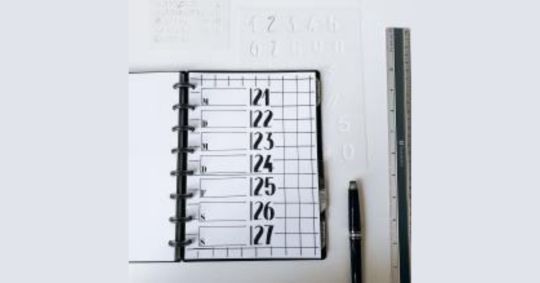
View On WordPress
2 notes
·
View notes
Photo
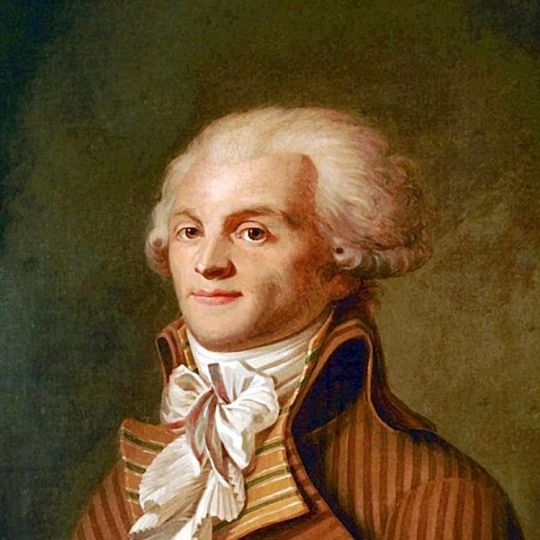
Maximilien Robespierre
Maximilien François Marie Isidore de Robespierre (1758-1794) was a French lawyer who became one of the primary leaders of the French Revolution (1789-1799). From his initial rise to stardom in the Jacobin Club, Robespierre went on to dominate the powerful Committee of Public Safety and oversee the Reign of Terror. He was overthrown and guillotined on 28 July 1794.
Beginning in May 1789, Robespierre's political career was brief yet impactful. He championed the will of the people with such a degree of conviction that he became known as the "Incorruptible"; a contemporary once mused that Robespierre was the type to pay a man to offer him a bribe so he could make a show of declining it. His strict adherence to his principles was drawn from a perceived mandate from the people. Robespierre considered himself to be the people's spokesman, which meant that those who opposed him necessarily opposed the people. Such would be his rise and his downfall.
Continue reading...
40 notes
·
View notes
Text

="[ A GRANDE CLAVÍCULA , LIVRO QUATRO 🍀 -: SECÇÃO H SUB-SECÇÃO H -ÔMEGA - QUINTUS ]"=
="{ As Nove Co-Tutoras de DOBIA-AMBROSINA -: Parte Quarta }”=
" Sucessivamente perguntei aos Tais Seres Contatantes Sobre das -: " Três -: DOBIA-AMBROSINA , BABA YAGA e DRUDE , no quanto aquele dia 12 de Abril de 2024 , que havia perguntado Onde estavam , e nesta Nova Pergunta , Responderam -:
" DRUDE se Encontrava ao Lado de FREYJA , com Nesta Ênfase as Já Mencionadas OUTRAS que Conversavam Dentre Si , Junto as mesmas Estando AGLAOPHÊNIA Sentada na Poltrona , Mas no Ambiente Outro que é Alheio ao Ambiente no qual o Descrente se Encontrava , e que por Nossa Indicação , o Descrente lhe Apontou como Preliminar , pois é o Ambiente Mais Próximo do Ambiente no qual o Descrente Está , e que se Refere a Formalidade Convencional da Casa 🏡 , Onde no mesmo Simultâneo Ajustado e Sequente Contínuo , Esta DRUDE se Encontrava Lá e no mesmo Instante Ajustado , Sentada na Poltrona , no Ambiente no qual o Descrente se Encontrava , em seu Quarto , então Conversando com DRUDE , Desdobrada ..., quando Chegou em Co- Ubiquidade HÉSTHER HÁLGAMAS HÉLLIONDRAH para Saber d Algo Referente a Conversa que AGLAOPHÊNIA Acompanhada de DRUDE Estavam Tendo com as OUTRAS que Naquele Momento Não se Encontravam no Ambiente no qual em seu Quarto , o Descrente se Encontrava...,
que no por Detrás Daquele Ambiente Mais Próximo e Preliminar ao Ambiente Outro ,o Intermediário que se Dá por Detrás do Preliminar ou Antecedente , Hão Ambientes por Detrás de Ambientes , Além do Ambiente Intermediário , em Quanto ao por Detrás da Casa 🏡 , com suas Conexões com Outros Ondes por Detrás desta Terra , e no Exterior da mesma , ào Mais Além..., que é Nestes Outros Ambientes , Onde se Dão os Formados Grupos que Constituem uma Comunidade (...)."
AGLAOPHÊNIA , Segundo os Seres Contatantes que Não Procedem desta Terra 🌎🌍 , é um dos Reflexos Espelhados de HEZAHLLIÉDRAH , que por sua vez é uma das Nove Manifestações Diferenciadas de RUDRAHEXTHILLAH , que são a própria RUDRAHEXTHILLAH , Sendo AGLAOPHÊNIA a mesma que se Semi-Humanizou e Apareceu Sem Nascer para Acompanhar Alexandre Magno que é o mesmo Wilhelm Richard Wagner , que em Sucessivo Veio como Howard Philips Lovecraft , em Vinda Outra , Enviado em Quanto a Real data de sua Vinda Alheia as Fraudes Históricas Remotas Re-Ajustadas pelo Index próprio da Igreja de Roma...,
e as Alterações da Nobre e Verdadeira História de Alexandre Magno proporcionadas pelo Apontado Index , que Alexandre Magno Veio com Ajustada Magnitude Maior que a de si mesmo , quando em Vinda Outra Sucessiva Veio como Wilhelm Richard Wagner , na Alemanha...,
e Sob um Raio de Ultra- Sincronização que Dá Mais Capacidades que os Vários Tipos de Sincronização..., Alexandre Magno Veio , Aparecendo Sem Nascer e o Contatado Rei Felipe o Admitiu como seu Filho e Sucessor , Já AGLAOPHÊNIA que Apareceu Sem Nascer , em Certa Casa Sacerdotal Teve seu Nome a Ser Estátira , que Nunca foi Filha de Oxiartes e Nem foi Margeia por Este , Exceto nas Fraudes Históricas Remotas Re-Ajustadas pelo Index próprio da Igreja de Roma , onde Oxiartes era Grande Inimigo de Alexandre Magno , que Oxiartes em Reencarnações em Outra Época era o mesmo de Codinome Absalon e Nome Lamed Abdalla , o Maior dos Inimigos de Wilhelm Richard Wagner Nesta Terra , em quais das Vindas de Wagner...,
que Absalon na França em Outra Reencarnação era Maximilien François Marie Isidore de Robespierre...,
Já em Outra Época era Oxiartes...,
que Estátira era o Nome da mesma com Codinome Roxana (Roxane) Título da Rainha de Tiro Emblemático Atributal como a mesma Rainha de Sabá , que como Sacerdotisa do Templo de ASTARTÉ na Fenícia Tinha o Codinome Sabrina (...).
Está Desapareceu Sem Deixar Replica , e Sem Morrer , Já Alexandre Magno quando partiu Puxado pelas Forças Superiores do Mais Além desta Terra , deixaram para o Substituir uma Réplica (...) !
Já em Quanto aos Grupos Formados então Mencionados eram Dezenove que se Convergeram em Vinte e Sete , Cada qual com sua Regente e Duas Suplentes Co- Regentes , Além de suas Sub- Regentes , onde se Encontram em um Conselho Geral na Centralização Dentre Estes , que é Regido por MELUSINA e suas Duas Suplentes Co-Regentes , que são as mesmas que Dirigem o Grupo Central e Frentista Destacado que é o Grupo Dianteiro Dentre Estes Vinte e Sete Grupos...,
Integrados por Não Humanos Masculinos e os que São Femininos , Predominando os que são Femininos , Grupos Estes que Atuam em Sincronia com a Atuação das Forças Superiores do Mais Além desta Terra 🌎🌍..., Destes Vinte e Sete Grupos suas Regências são Compostas de Integrantes Apenas Femininos...,
Já por Outro Lado , Além destes Vinte e Sete Grupos , Hão os Oito Grupos que se Convergeram em Dezoito (18 : 6+6+6) onde os Integrantes Não Humanos são Alguns Masculinos e Outros Femininos , Predominando os Masculinos e cada Grupo Regido por um Regente e Dois Suplentes Co-Regentes , Além dos Sub- Regentes Onde Formam estes Dezoito Grupos um Conselho , Regido pelo Regente e Co- Regentes do Grupo Central Destes , Onde LÓKI (LOKI) é seu Regente Supremo..., Destes Dezoito Grupos os Regentes e Co- Regentes são Todos Masculinos , Onde os Dezoito Grupos com os Vinte e Sete Grupos , em Total São Quarenta e Cinco (45= 4+5=9) Grupos , Formam o Conselho - Amálgama - Expoente- Supremo- Central -: Dirigido por LÓKI (LOKI) e por MELUSINA...,
Já dos Dezoito Grupos Mencionados que Estão em Ambientes Mais Distantes no Quanto a Relatividade no por Detrás do Ambiente no qual o Descrente se Encontra em quanto ao Ambiente que Expede o Referente Relativo a Formalidade Convencional da mesma 🏡...,
por Detrás deste Ambiente , Havendo Ambientes por Detrás de Ambientes , cada Qual com sua Confirmação Diferente do "Cenário e Mais" , com suas Conexões Inter- Ligadas e que se Ligam em Respectivo a "Ondes que Envolvem Lugares e Distintos que Não se Fundamentam como Lugares , que Segundo os Seres Contatantes Lugar é Diferente de Local que se Relaciona com Localidade que é o Co- Enquadramento do Lugar Quanto ao Local , onde -: " Local é o Onde no qual se Explana o Lugar...,"
Lógo -: " Ondes e Distintos " no quanto ao por Detrás desta Terra 🌎🌍 , Referindo por sua vez , Nesta Ênfase a " Mundos e Distintos que Não São Mundos e São Amplamente Habitados ...,"
e no por Detrás do Exterior da Terra 🌎🌍 e mesma Esfera Planetária , e no por Detrás do Exterior ao Espaço Descomunal , que é Finito e Tem Campo e Eixos e em Quanto ao Espaço Descomunal se Referem -: " os Planos e Meios de Existência " com seus " Mundos e Outros Distintos " , que por sua vez estão Inseridos como cada qual sendo Similar a um Ponto Dentro de um Caleidoscópio , em Onde Tal Ponto se Reflete Equivale Nesta Metáfora as " Dimensões e Tangentes Co-Paralelas" nas Quais o Ponto Alcança Existência , sendo que Hão Três Mil Dimensões e para Cada Uma , Há sua Relacionada Tangente Co-Paralela , e Cada Dimensão e Cada Tangente Co-Paralela se Divide em -: Faixas Interpostas em Toda a Extensão do Espaço , e em Oitava Superior Além das Faixas Hão os Extratos Interpostos em Toda a Extensão do Espaço , e em Oitava Superior Além dos Extratos , Hão os Ultras ou Ulteriores Interpostos em Toda a Extensão do Espaço , e CadaFaixa , Extrato e Ultra ou Ulterior Tem uma Faceta Diferente do Tempo e sua Escala de Frequências , em Exemplo o que Existe em uma Frequência à Margeantes Frequências em dada Faixa , Não Existe em Frequência à Frequências Margeantes Outras , onde o Cenário é Diferente na mesma Faixa , que as Dimensões e Tangentes Co-Paralelas se Assentamento nos Quase Doze Mil Níveis do Espaço e que o Tal Mundo Infértil que na Ênfase em desde o Período Pós Glacial se Convergeu no-: "Atual e Mais que Transitório e Passageiro Esquema Mundial com suas Nações Atuais , e em Tal Mundo Infértil Específico Há a Flora , Fauna e o Mais..., Alcança Existência em uma das Faixas e em dada Frequência à Frequências Margeantes , em Quanto Nesta Ênfase a Dimensão Designada Física , Faixa Dimensional Específica com sua Escala de Frequências e Faceta Específica do Tempo em Toda a Extensão do Espaço , Onde Existe Tal Esfera Planetária Chamada pelos Enfáticos " humanos" de Tal Faixas Específica , Terra e para a qual os Seres Contatantes dão Outros Nomes ...,
que a Terra e mesma Esfera Planetária , Alcança Existência em 94 Dimensões e suas Relacionadas Tangentes Co-Paralelas , Já a Galáxia Chamada" Via Láctea" Alcança Existir em 141 Dimensões e suas Relacionadas Tangentes Co-Paralelas Ante as Três Mil Dimensões e suas Relacionadas Tangentes Co-Paralelas próprias do Espaço que Não é o Universo , Mas o Universo Contém o Espaço com Algo que é Exterior ao Espaço Descomunal , que o Universo é Finito , Tem Campo, Eixos e Forma de Poliedro que se Vertem em Esfera com Reflexos Multicoloridos e Fora do Universo Há (...)-: "o Grande Vazio Interposto por Distintos ", que Interposição aqui se Refere -: " Um Ocupa o mesmo Onde do Outro , Sem se Mesclar ou Confundir ,como em Frequência Distinta "...,
e que Dá Acesso a Unidades Expoentes Bem Distanciadas Uma da Outra, Algumas Maiores que o Universo e que Não tem Fundamentação que as Caracterizaria para poderem ser Chamadas de Universos e Dentre Estas está o Universo , Ante o Mais Além Inimaginável , pois a " Criação é Mais Abrangente " , e Desta -: " o Universo é como um Insignificante Grão de Areia...,"
onde Já o que se Referem aos Ambientes Mencionados no por Detrás da Casa 🏡 , se Conectam Também ao Exterior do Universo , ao Além Inimaginável...,
pela Efetivação dos Não Humanos -: Deuses- Demônios , Deuses , Demônios , Variações Co- Demoníacas , Feéricos ou Elementais e Variantes Feéricas e Distintos...,
que Atuam em Sincronia com a Atuação das Forças Superiores do Mais Além desta 🌎 🌍...,
Ante o Vislumbrar do Supremo dos Supremos...,
que Criou os Não Humanos Mencionados e que Estabeleceu as Forças Superiores do Mais Além desta Terra com seus Comandos e Lideranças -: que com os Não Humanos Mencionados são -: " os Intermediários Entre DEUS e a"Criação Mais Abrangente...,"
e o Mais Indizível Relacionado com o Grande Desconhecido..., DEUS ...,
O SUPREMO SOBERANO DOS SOBERANOS ...,
que é (...)-:
IHVH...,
AHEHIE ASHR EHEIEH...
ALLAHU AKBAR...,
THEOS : DEO...,
ALLAH...,
O GLORIOSO DEUS INDIZÍVEL...,
O VERDADEIRO INOMINÁVEL...,
COM SEUS NOMES , FACETAS E MISTÉRIOS SAGRADOS (...)!!! ! !!! "
( Continua em H- ÔMEGA - SEXTUS )
1 note
·
View note
Text
wish my brain was normal and picked a new white man from reasonable places like marvel movies or gacha games. like bro why the fuck are you beginning to obsess over the infamous french revolutionary Maximilien François Marie Isidore de Robespierre
0 notes
Photo
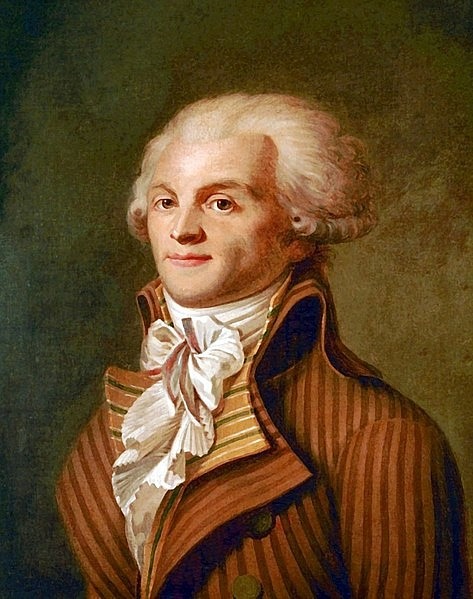
Maximilien de Robespierre
Maximilien François Marie Isidore de Robespierre (1758-1794) était un avocat français qui devint l'un des principaux dirigeants de la Révolution française (1789-1799). Après une première ascension au sein du club des Jacobins, Robespierre domina le puissant Comité de salut public et supervisa le règne de la Terreur. Il fut renversé et guillotiné le 28 juillet 1794.
Lire la suite...
0 notes
Photo
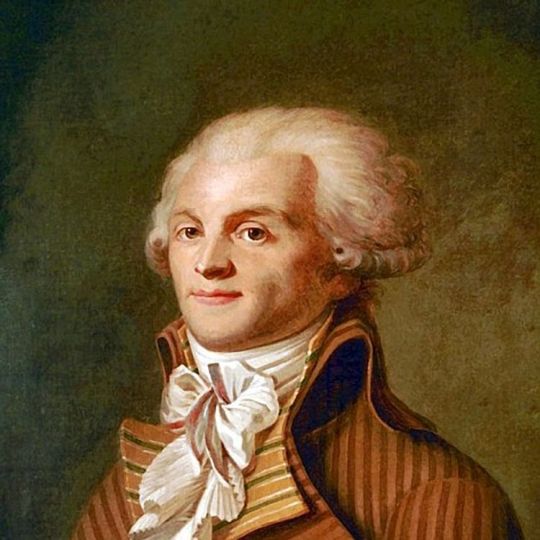
Maximilien Robespierre
Maximilien François Marie Isidore de Robespierre (1758-1794) fue un abogado francés que se convirtió en uno de los principales líderes de la Revolución francesa (1789-1799). Desde su ascenso inicial al estrellato en el Club Jacobino, Robespierre pasó a dominar el poderoso Comité de Seguridad Pública y a supervisar el Reinado del Terror. Fue derrocado y guillotinado el 28 de julio de 1794.
Leer más...
0 notes
Note
Je n'ai pas envie de traduire ce texte en anglais, alors je ne vais pas le faire. Je viens d'arriver ici et je ne connais pas cet endroit et ne m'y intéresse pas. Mon nom est Maximillien Robespierre, comme les Américains m'appellent. Je ne supporterai aucune merde de la part de gens qui n'ont pas aidé mes efforts et qui, en retour, se sont fait couper la tête.
De
Maximilien François Marie Isidore de Robespierre
*Crumple the paper and throw it away*
1 note
·
View note
Text
Along with it being the release date for the emoji movie, my birthday also marks the death of Maximilien François Marie Isidore de Robespierre. Ya know, a former member of the French Revolution’s National Assembly before the he was beheaded for beheading too many people
1 note
·
View note
Text
Le secret de la liberté est d'éclairer les hommes, comme celui de la tyrannie est de les retenir dans l'ignorance. ["The secret of liberty is to enlighten men, as that of tyranny is to keep them in ignorance."]
--Maximilien Robespierre, November 1792
#Robespierre#Maximilien Robespierre#Maximilien François Marie Isidore de Robespierre#quote#Robespierre quote#liberty#freedom#enlightenment#education#tyranny#ignorance
22 notes
·
View notes
Text
Robespierre family timeline
Below is a timeline over the life of Robespierre’s closest relatives between the marriage of his parents up until their deaths because people seemed to drop like flies around him his entire childhood and I felt the need to put some things in order. Most of it is based on information found in La famille de Robespierre et ses origines. Documents inédits sur le séjour des Robespierre à Vaudricourt, Béthune, Harnes, Hénin-Liétard, Carvin et Arras. (1452-1790) (1914) by A. Lavoine, La Jeunesse de Robespierre et la convocation des Etats génétaux en Artois (1870) by J.-A. Paris, Robespierre: a revolutionary life (2010) by Peter McPhee, Robespierre (2014) by Hervé Leuwers, as well as this family tree that I found. If I’m basing something below on anything that’s not in one of these sources, I will include a link to it.
January 2 1758 - The marriage contract between Maximilien Barthélémy François de Robespierre (born 1732, from here on called Maximilien II) [1] and Jacqueline Marguerite Carraut (born 1735) is passed before M. Crépieux and M. Botte, notaries, M. Corroyer, prosecutor, as well as Jacqueline’s mother Marie-Marguerite Carraut (born 1693, née Cornu), father Jacques-François Carraut (born 1701) and younger brother Augustin-Isidore Carraut (born 1737). Maximilien II’s parents Maximilien de Robespierre (born 1694, from now on called Maximilien I) and Marie-Marguerite Françoise de Robespierre (born 1708, née Poiteau) are not present. [2]
January 3 1763 - wedding ceremony between Maximilien II and Jacqueline de Robespierre in the church of Saint-Jean-en-Ronville. Their witnesses are M. Monvoisin, practitioner, M. Corroyer, prosecutor, M. Botte, notary, Jacques-François Carraut and Augustin Carraut.
May 6 1758 - birth of Maximilien Marie Isidore de Robespierre (from here on called Maximilien III). He is baptised in the parish of Sainte-Marie-Madeleine in Arras the same day, with his paternal grandfather standing as godfather and maternal grandmother standing as godmother. [3]
February 5 1760 - birth of Marie Marguerite Charlotte de Robespierre. She is baptisted in the parish of Saint-Étienne in Arras three days later. Her godparents are Gouve Charles-Antoine, King's adviser and prosecutor of the town and city of Arras, subdelegate of the intendant of Flanders and Artois, and Marie-Dominique Poiteau, widow Isambart. [4]
13 January 1761 - marriage between maternal uncle Augustin Isodore Carraut and Catherine Sabine Desplanque (born 1740) in Magnicourt-sur-Canche, Pas-de-Calais. They have five children together, Augustin Louis Joseph (1762), Antoine Philippe (1763 or 1764-1837), Marié Célestine (born 1767 and dead on the same day), Jean-Baptiste Guislain (1768-1797) and Sabine Josephe (1771-1860). [5] The second oldest, Antoine Philippe, will come to play a role in the repression of Arras carried out under Joseph Lebon 1793-1794.
December 28 1761 - Birth of Henriette Eulalie Françoise de Robespierre. She is baptised in the parish of Saint-Étienne in Arras the same day. Her maternal grandfather and paternal grandmother stand as godparents. [6]
April 17 1762 - death of Maximilien I, at the age of 67. He’s buried in the church of Saint-Aubert two days later. The death certificate is signed by his son and Pierre-Grégoire-Marie Enlart, squire, lord of Grandval, adviser to the Provincial Council and Superior of Artois. His widow then retires to the Convent of the Benedictines of the Peace of Arras.
January 21 1763 - birth of Augustin Bon Joseph de Robespierre. He is baptised in the parish of Saint-Étienne in Arras the day after his birth, with his godfather being his maternal uncle Augustin Carraut and godmother the paternal aunt Marie-Marguerite Alexandrine Eléonore Eulalie de Robespierre (born 1736). [7]
July 4 1764 - Jacqueline de Robespierre gives birth to a boy who dies the same day. He is buried in the Saint-Nicaise cemetery, without having received a name. According to Charlotte’s memoirs, Augustin was still with a wetnurse when this happened.
July 16 1764 - death of Jacqueline de Robespierre, a few days before her twenty-ninth birthday. Her funeral is held in the parish of Saint-Aubert the following day. The mortuary act is signed by her brother and Antoine-Henri Galbaut, Knight of Saint-Louis, assistant major of the Citadel. Her husband doesn’t sign it, nor does he attend her funeral. [8]
August 6 1764 - Maximilien II retakes his duties as lawyer at Arras after having spent a few weeks without doing any business. He wins and loses a case that day.
November 16 1764 - the name of Maximilien II ceases to appear on the court register of the Council of Artois.
January 7 1765 - Maximilien II is received as a lawyer at the court of Oisy, about 20 kilometers from Arras, after having been called on by Eustache-Joseph d'Assignies, count of Oisy, to take a prestigious seat there, "on the express condition of taking up residence in said Oisy and not being able to demand from us any sums for fees in criminal cases” eight days earlier. By then, his four children have been dispersed among relatives, Charlotte and Henriette are taken care of by their unmarried paternal aunts Eulalie (born 1735) and Henriette (or are they? [9]), while Maximilien III and Augustin are sent to live with their maternal grandparents. [10] Maximilian II will not retain his functions at Oisy forever however, as the same manuscript which contains his commission also registrates the appointment of his replacement for July 15 1765.
March 13 1765 - Maximilien II is back in Arras (four months before his position at Oisy expires) pleading a case, which carries on all the way into December of the same year. [11]
March 22 1766 - Maximilian II borrows seven hundred livres from his sister Henriette. It would appear he never paid them back, which led to some tension between Henriette, her husband and Maximilien III in 1780. [12]
1766 - Maximilien III is enrolled at the Collège of Arras as a day-student.
October 30 1768 - Maximilien II resigns from any inheritance whatsoever from his mother. [13]
December 30 1768 - Charlotte de Robespierre is enrolled at Maison des Sœurs Manarre, “a pious foundation for poor girls, who may be admitted from the age of nine to eighteen, to be fed, brought up under some good mistress of virtue and to improve oneself in lacing and sewing or in another thing which one will judge useful; to learn to read and write until they are able to serve and earn a living." It is situated just across the border in Tournai (modern-day Belgium). Charlotte is actually a few months too young to actually be enrolled, but an exception seems to be made in her case. According to La famille de Robespierre et ses origines…, it was Charlotte’s godfather Charles-Antoine de Gouve that had enough influence to obtain this favour for her.
September 13 1769 - Maximilien III obtains a scholarship from the abbot of Saint-Vaast to the college of Louis-le-Grand in Paris.
October 13 1769 - Maximilien III is enrolled at Louis-le-Grand.
May 17 1770 - death of Marie-Marguerite Françoise de Robespierre, aged 62. She is buried in the church of Saint-Aubert two days later in the presence of of M. Sébastien-Fidel de Douay, de Baisne, priest, law graduate, and Antoine de Gouve, bourgeois annuitant witnesses. The death certificate is signed by the two latter.
June 8, 1770 - Maximilien II confirms his resignation from the inheritance of his mother, after being informed about her death by his sisters. He is then in Mannheim, Germany. [14]
May 3 1771 - Henriette de Robespierre is sent to join her sister at Maison des Sœurs Manarre, where she stays as a boarder while waiting for a scholarship to become vacant.
October 3 1771 - Maximilien II, back in Arras, affirms he doesn’t want any of his mother’s inheritance yet again. [15]
February 17 1772 - the name of Maximilien II reappears on the court register of the Council of Artois.
June 4 1772 - the name of Maximilien II ceases to appear on the court register of the Council of Artois. There’s no sign of his activities in the town after this.
June 4 1773 - Henriette de Robespierre becomes a scholarship student at Maison des Sœurs Manarre. [16]
June 13 1775 - Death of Marie Marguerite Carraut, aged 83.
January 7 1776 - Marriage between Eulalie de Robespierre and Robert-François Deshorties, merchant and royal notary in Arras. [17]
February 11 1777 - Marrige between Amable Aldegonde Henriette de Robespierre and Gabriel-François Durut, student in Montpellier, doctor of medicine in Arras, doctor at the College d’Oratoire. Their marriage, as well as the one between Eulalie and Deshorties, appears to have been childless, making the Robespierre siblings cousin-less on their father’s side.
November 6 1777 - Maximilien II is buried in Munich, aged 45. His children most likely didn’t find out about his death.
March 14 1778 - death of Jacques François Carraut, aged 77. He’s buried two days later in the parish of Saint-Jean-en-Ronville in Arras. His brewery is sold to his son Augustin for a total of 8242 livres, of which only half goes to the four orphans.
March 5 1780 - Henriette de Robespierre is buried. Her uncle Augustin Carraut and the canon Poulain are the only ones present at her funeral.
May 15 1781 - Maximilien III graduates from Louis-le-Grand and returns to Arras to work as a lawyer. He and Charlotte move into a house on Rue du Saumon.
October 11 1781 - Augustin gains a scholarship to Louis-le-Grand. He begins his studies there on November 3 the same year. All sources I’ve found agree that Augustin was studying at the College of Duoai before getting sent to Paris, but unfortunately none of them mention when exactly he was enrolled there.
Late 1782 - Maximilien II and Charlotte are forced to leave Rue du Saumon when the latter realizes his lawyer salary can’t cover the rent. They instead move in with their aunt Henriette and her husband Durut on Rue Teinturiers, and evantually from there to Rue des Jésuites.
1787 - Maximilien II and Charlotte move to Rue des Rapporteurs 9.
September 30 1787 - Augustin graduates from Louis-le-Grand and moves in with his siblings.
April 17 1791 - death of Amable Aldegonde Henriette de Robespierre in Arras, aged 55.
September 3 1791 - death of Eulalie de Robespierre in Arras, aged 54.
December 6 1792 - death of Robert-François Deshorties in Arras.
November 17 1815 - death of Augustin Carraut in Arras, Pas-de-Calais, aged 78.
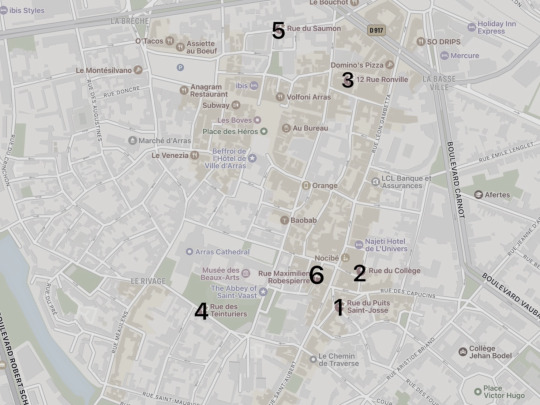
Rue du Puits Saint-Josse, where Maximilien I lived at the time of his death in 1762
Rue des Jésuites (today Rue du Collége) where the Robespierres lived by the time of Augustin’s birth in 1763. The family moved around a lot, in four years it changed residence four times and lived successively in the parishes of St-Géry, Ste-Marie Madeleine, St-Etienne and St-Aubert. Amable-Aldegonde-Henriette de Robespierre’s husband Durut also became tenant of a house on this road in 1783, for an annual rent of 300 livres.
Rue Ronville, where Jacques-François Carraut had his brewery, and where Maximilien III and Augustin moved in 1764.
Rue des Teinturiers, where Amable-Aldegonde-Henriette de Robespierre and her husband Durut lived before 1783. This is likely the place where Henriette de Robespierre passed away in 1780. Maximilien III and Charlotte took up lodgings there in late 1782, after the former realized he could not afford to pay their rent.
Rue du Saumon, where Maximilien III and Charlotte rented a recidence before moving in with their aunt and uncle in 1782. When Maximilien’s income increased, they moved again, to Rue des Jésuites this time.
Rue des Rapporteurs (today Rue Maximilien Robespierre), where Maximilien III and Charlotte moved in 1787. They were soon joined by Augustin.
[1] There is some controversy regarding Robespierre’s father’s actual firstname, since there exists one document describing him as Barthélémy-François, and another one as just Barthélémy (although ironically, it’s more common among authors to call him François and not Barthélémy). Historian Hervé Leuwers still insists that his real firstname seems to be Maximilien, as it’s what his contemporary Abbé Proyart calls him in his La Vie et les Crimes de Robespierre: surnommé le tyran: depuis sa naissance jusqu’au sa mort (1795), as well as the only name indicating his inhumation in 1777.
[2] ”As for the the groom, M. Corroyer, in his capacity, has promised to give him the sum of two thousand livres, either in money or in constituted annuities, as soon as the marriage has been celebrated... As for the the bride, her father and mother have promised to give her a sum of five thousand livres payable, namely: two thousand livres immediately after the celebration of the marriage, one thousand livres one year after said celebration and thus continue on with one thousand livres per year until the final payment of the said sum of five thousand livres. The marriage was celebrated in the presence of Jacques Francois Carraut; Monvoisin, practitioner; Corroyer, attorney; Botte, notary, and Carraut the younger.”
Wedding contract from January 2 1758, cited in La Jeunesse de Robespierre…, page 13
[3] ”The sixth of May, 1758 was baptized by me the undersigned Maximilien-Marie-Isidore, born the same day at two o'clock in the morning in the legitimate marriage of M. Maximilien-Barthélemy-François Derobespierre, lawyer at the Council of Artois , and demoiselle Jacqueline Carraut. The godfather was M. Maximilien Derobespierre, grandfather on the paternal side, lawyer at the Council of Artois, and the godmother, demoiselle Marie-Margueritte Cornu, wife of Jacques-François Carraut, grandmother on the maternal side. These have signed.
Derobespierre. Marie-Marguerite Cornu.
Derobespierre. Lenglade, priest.”
Cited in Robespierre et les femmes, d’apres des documents inédits et des pieces inédits (1909) by A. Michel, page 20
[4] ”Today is the eighth day of the month of February, the year 1760. We priests of the parish of Saint-Étienne of towns and Diocese of Arras, have supplemented the ceremonies of the baptism for a girl born around half past two in the afternoon in said parish in the legitimite marriage of maître Maximilien-Barthélemy-François de Robespierre, lawyer at the Provincial Council of Artois, and of demoiselle Jacqueline-Margueritte Carraut, her father and mother; she was delivered by us parish priest the day after her birth, six of the same month and year as above, with the permission of the bishopric dated the same day signed by Le Roux, vicar general, and below, by ordinance Péchena. The godfather was master Charles-Antoine de Gouve, adviser to the King and his attorney for the town and city of Arras, subdelegate of the intendant of Flanders and Artois, in the department of Arras, of the parish of Saint-Jean in Ronville, and the godmother demoiselle Marie-Dominique Poiteau, widow of Sieur François Isambart, procurator to the said provincial council of Artois, of the parish of Saint-Aubert, who gave her the name Marie-Marguerite-Charlotte, and who signed with us the parish priest, and the father here present, the same act on the day and year mentioned above. The child was born on the fifth.
Marie Dominique Poiteau
De Gouve
Derobespibrre
Willart, parish priest of Saint-Etienne.”
Cited in Ibid, page 323-324
[5] I had a hard time finding any reliable info regarding dates of birth (and death) for Robespierre’s five cousins. I found one article from 1991 about them as well as one on WikiTree, however, the two give different dates of birth for some of the children.
[6] “Today, the twenty-eighth day of the month of December, 1761, we priests of the parish of Saint-Étienne, of the town and diocese of Arras, have baptized a girl born on the same day in this parish of Saint-Étienne around six o'clock in the morning in the legitimate marriage of Maître Maximilien-Barthélemy-François de Robespierre, lawyer at the Provincial Council of Artois, and demoiselle Jacqueline-Marguerite Carrant, her father and mother our parishioners. The godfather was sieur Jacques-François Carraut, wholesale merchant brewer of the parish of Saint-Jean en Ronville, maternal grandfather to the child and the godmother demoiselle Marie-Marguerite-Françoise Poiteau, wife of master Maximilien de Robespierre, lawyer at said Provincial and Superior Council of Artois, of the parish of Saint-Aubert, paternal grandfather to said child, who gave her the name Henriette-Eulalie-Françoise and who signed with us parish priest, the same act as well as the father here present at said Arras on the aforesaid day, month and year.
Jacque (sic) François Carraut
Poiteau de Robespierre
Derobespierre
Willart, curé de Saint-Eteinne”
Cited in Robespierre et les femmes… (1909), page 326-327
[7] ”Today, the twenty-second day of the month of January of the year 1763, we priest of the parish of Saint-Étienne des Villes and diocese of Arras have baptized a boy born the day before, about two o'clock in the afternoon, the twenty-first of the same month and year, on this said parish in the legitimate marriage of master Maximilien-Barthélemy-François de Robespierre, lawyer at the Provincial Council of Artois and demoiselle Jacqueline-Margueritte Carraut, his father and mother our parishioners. The godfather was Augustin-Isidore Carraut, merchant of the parish of Saint-Jean en Ronville, maternal uncle of the child, and the godmother demoiselle Margueritte-Alexandrine-Éleonore-Eulalie de Robespierre of the parish of Saint-Aubert, paternal aunt of said child, who gave him the name Augustin-Bon-Joseph and who signed the same act with us as priest as well as the father here present on the days, months and year mentioned above.
Carraut
Eulalie de Robespierre
Derobespierre
Willart, curé de Saint-Eteinne”
Cited in Ibid, page 327-328
[8] ”Demoiselle Marguerite-Jacqueline Carraut, aged twenty-nine or thereabouts, wife of M. Maximilien-Barthélemy-François Derobespierre, lawyer at the Provincial and Superior Council of Artois, died on the sixteenth of July in the year 1764; the service was held on the seventeenth, followed by her burial in this church, those present were the sieurs Antoine-Henry-Galhaut, knight of the royal and military order of Saint-Louis, aide-major by patent of the citadel of Arras, and Auguste-Isidore Carraut, brother of the deceased, who signed with us as parish priest.
Galhaut. De Lacroix, priest
Carraut.”
Cited in Ibid, page 323-324
[9] According to La famille de Robespierre et ses origines. Documents inédits sur le séjour des Robespierre à Vaudricourt, Béthune, Harnes, Hénin-Liétard, Carvin et Arras. (1452-1790) the paternal aunts Eulalie and Henriette retired to Convent of the Benedictines of the Peace of Arras with their mother when the latter was widowed in 1762, where they would not have been able to provide for their nieces. The article instead implies all four children were taken in by their maternal grandparents, which it also uses to explain why Charlotte was enrolled at Maison des Sœurs Manarre despite being a few months too young to actually be admitted, and why Henriette was enrolled without having a scholarship — their grandparents simply had to quickly send them away since they couldn’t provide for all children. However, it doesn’t cite a source for the aunts’ alleged move, and both Leuwers and McPhee list the article as one of their sources while still writing Charlotte and Henriette went to live with their aunts, so I’m not sure about this.
[10] In his biography, Peter McPhee claims Maximilien III was also looked after by two maternal aunts. However, I’ve not managed to track down any information whatsoever on these, and the few Carraut family trees I’ve found only mention Jacqueline, Augustin and a third brother named Jean-Baptiste who probably died young since more or less no info exists regarding him. Worth noting is also that Mcphee says the maternal aunts were called Eulalie and Henriette, which were the names of the paternal aunts as well… This confusion is most likely a result of poor choice of wording by Abbé Proyart in his La Vie et les Crimes de Robespierre: surnommé le tyran: depuis sa naissance jusqu’au sa mort (1795) — ”Not being heir to any patrimony, he (Robespierre) had no resources for his subsistence except those which could be procured for him by the honest brawler Carreau (sic), his grandfather, and the charity of good people, which were quite efficiently encouraged by two aunts of the same name, who lived in a great reputation for piety.” Proyart most likely means the aunts were of the same name as Robespierre and not his grandfather, which is supported by the fact that he then claims one of them married a doctor, just like Eulalie de Robespierre did.
[11] On December 9 the same year, Maximilien II wrote a a letter to his fellow lawyer Maximilien Baudelot, in which he identified himself as a lawyer of Arras while trying to get them to all come together and publicy plead for the betterment of the the dauphin, who died eleven days later. This confirms he was still active in Arras at this point.
[12] ”Hearing of April 4, 1780: M. Corne, for François-Gabriel Durut, doctor of medicine, and Amélie-Aldegonde-Henriette Derobespierre, his wife; Against François-Maximilien-Barthelemy de Robespierre; Gentlemen give default against François-Maximilien Robespierre and for the benefit, hold the signature affixed by the defaulting party at the bottom of a recognition of March 22 1766 which it is about for recognized; Consequently, we condemn said defaulting party to pay to the parties of the attorney Corne, for one part, the sum of seven hundred and eleven livres ten sols, centenary in said recognition, and for another part, the sum of one hundred livres paid in his acquittal to the notary Husson, for pension provided to him according to the receipt of March 14, 1772 and in question, in the interest of the sums quoted from the day of the judicial demand and at the costs, liquidated at fifteen livres eighteen sols eight denarii.”
Cited in Mémoires de l’Académie des sciences, lettres et arts d’Arras, series 11, volume 3, page 56-57.
[13] ”I, the undersigned, lawyer at the Provincial Council of Artois, renounce, for the benefit of my sisters, my rights and shares in the movable and immovable estates of my mother, acknowledging that I have received from said mother beyond the share that I could claim, both for me and for my children.
Written at Arras, the thirtieth day of October, 1768
(Signed): DEROBESPIERRE”
Cited in La famille de Robespierre et ses origines. Documents inédits sur le séjour des Robespierre à Vaudricourt, Béthune, Harnes, Hénin-Liétard, Carvin et Arras. (1452-1790)
[14] ”I, the undersigned, lawyer at the Provincial Council of Artois, hereby renounce for the benefit of my sisters all rights and shares in the movable and immovable estates of my late mother, acknowledging that I have received from said mother beyond the share that I could claim, both for me and for my children.
Written at Mannheim, June 8, 1770”
Cited in Ibid
[15] ”Before the undersigned royal notaries of Artois appeared M. Maximilien-Barthélemy-François de Robespierre, lawyer at the Superior Council of Arras, residing in said Arras.
Who recognized that, by an act made under his private signature, in the city of Mannheim, on the eighth day of June 1770, he declared that he renounced the movable and immovable successions of lady Marie-Marguerite-Françoise Poiteau, his mother, at the time of her death widow of M. Maximilien de Robespierre, lawyer at the Council of Artois. But, having since considered that this renunciation could not have its effect, considering that at that time, he did not have full and complete knowledge of the forces of said succession and that, since his return to this town, three months ago, he has taken perfect knowledge of said estates by inspecting the letters and papers abandoned by said mother, which Marie-Marguerite-Alexandrine-Eléonore-Eulalie and Amable-Aldegonde-Henriette de Robespierre, his sisters, represented and entrusted to him. This is why said sieur appearing has, hereby, declared to renounce said successions and to claim nothing hereunder, giving power to the bearer of the bulk hereof to reiterate where and to whom it will belong. And just now said ladies Marie-Marguerite-Alexandre-Eléonore-Eulalie and Aimable-Aldegonde-Henriette de Robespierre have appered; these have recognized that said sieur de Robespierre, their brother, has given them the titles and papers mentioned herein.
Passed in Arras, the third of October, 1771.
(Signed): de ROBESPIERRE; de ROBESPIERRE, the older; de ROBESPIERRE, the younger,
(and as notaries): MERCHIER, HUSSON.
Cited in Ibid
[16] “To Messeigneurs, Messeigneurs the Treasurer-General, Councilors and Clerks of the Estates and Finances of H. M. the Dowager Empress and Apostolic Queen of Hungary, Bohemia, etc. Begs in very deep respect Henriette-Josephe de Robespierre, native of the town of Arras, ten years old, saying that, in the hope of being received in the foundation of the demoiselles Manarre, in the town of Tournay, like her sister was, she would have boarded there from the month of May 1771 and remained there until now, and done all the duties to which are held those provided with this foundation to the satisfaction of the superiors. However, although there is a place which must be vacant towards the month of July this year, the Administrators of it are having difficulty in receiving it, obsanting certain regulations by which it would be said that there would only be the subjects of your Sacred Majesty who would be admitted there; but, as it does not present itself up to now, and that that which must leave there is also a foreign subject who was received there; she takes the very respectful liberty of addressing Your illustrious Lordships, My Lords, for your pleasure, taking favorable account of the pension expenses which she has paid since said day, May 3, 1771, and of the useful and advantageous qualities which she possesses for the good of the house, permit the Administrators to there receive the supplicant with the ordinary charges. It's grace... , etc.”
Cited in La Jeunesse de Robespierre, page 19
[17] Deshorties was the widower of Marie-Jeanne Langlet, with who he had two sons and three daughers. According to Charlotte, Maximilien III had been courting one of these daughters, Anaïs, for two to three years at the time of the Estates General, and there were marriage plans between the two.These were however broken up by the revolution and Anaïs instead got engaged to another lawyer, Léandre Leducq, who she married on August 7 1792. Another one of the children was Régis Deshorties, who kept up contacts with the Robespierres during the revolution. Here is a letter from him to Augustin written on July 18 1794.
#maximilen robespierre#robespierre#augustin robespierre#charlotte robespierre#henriette robespierre#frev
19 notes
·
View notes
Photo
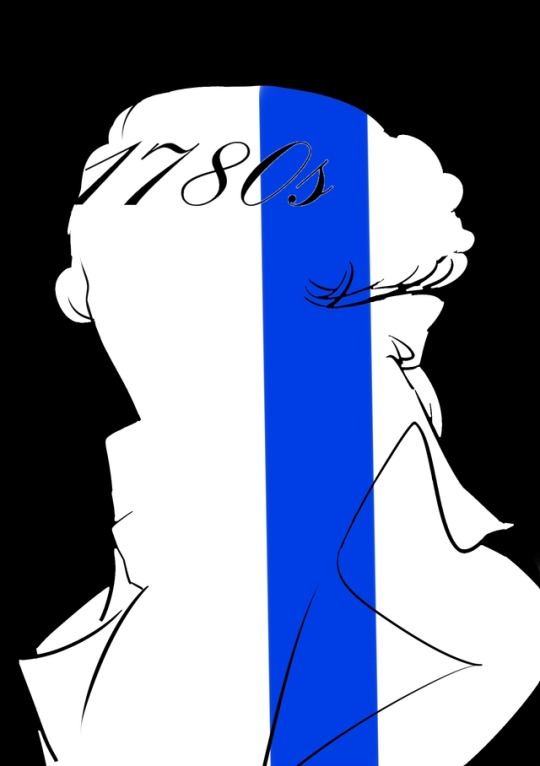
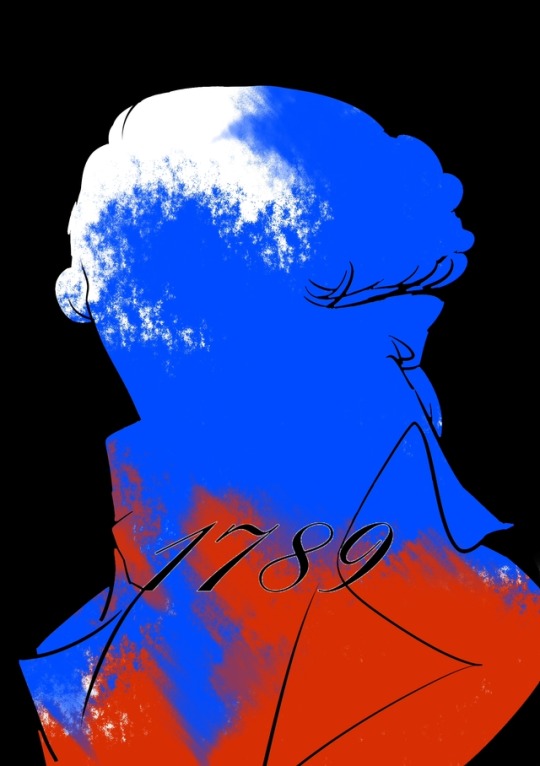
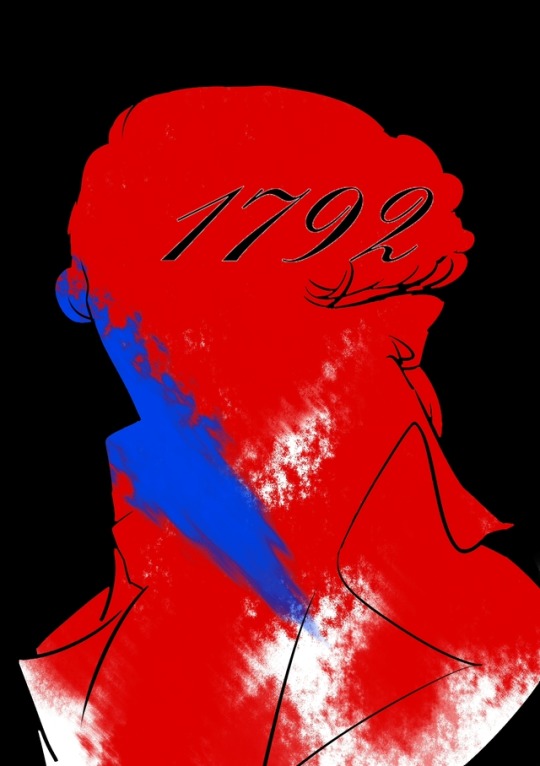


1758.5.6-1794.7.28
#Maximilien François Marie Isidore de Robespierre#robespierre#maximilien robespierre#french revolution#art#my art
34 notes
·
View notes
Text
@nicholewrites replied to this post...
I’m just gonna call you Robespierre from now on because everyone is dead apparently XD
So I’m an uneducated dummy and had to look up who this is, and so far the two main points that stand out to me are:
His name was ridiculously long - what kind of parent names their child Maximilien François Marie Isidore de Robespierre
And secondly, he glorified the Reign of Terror during which 16,594 people died
....this seems like an apt nickname
#he's my new favorite historical figure#Maximilien François Marie Isidore de Robespierre#yikes#incandescent replies#nicholewrites#SIX AND A HALF#or you know#sixteen thousand#same difference
5 notes
·
View notes
Text
❝ are those… bones…? ❞

“What?” Maximilien looked up from his paperwork at the woman’s question, and then back to the skeleton before him. “Non.” he replied as he stood up, looking over the woman, recognizing her instantly. “Paper mache.” he explained quietly. “It is interesting to meet you, Mme. de Gouges.” he said with a bow. “I believe you know where you are here.”
@ghostlymuses
#we love a shit post that probably wasn't even historically possible#and its a SHITTY MEME REPLY IM SORRYYYYYYYYY#« maximilien françois marie isidore de robespierre »#d:olympe
1 note
·
View note
Photo


if i were haruhi i would simply take out the guillotine and call myself maximilien françois marie isidore de robespierre and start my own reign of terror right there in ouran academy
#ohshc#hikaru hitachiin#kaoru hitachiin#tamaki suoh#haruhi fujioka#ouran highschool host club#doodoo.jpg#*slaps the roof of the host club* this thing can fit SO MANY DUMB BITCHES INSIDE IT!!
1K notes
·
View notes